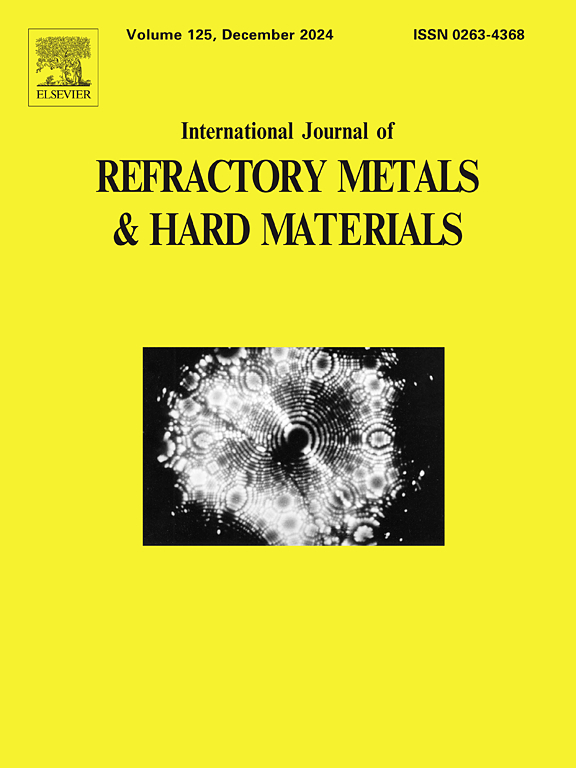WC coarsening in cemented carbides during sintering. Part II: Mechanisms of the influence of different grain growth inhibitors
IF 4.2
2区 材料科学
Q2 MATERIALS SCIENCE, MULTIDISCIPLINARY
International Journal of Refractory Metals & Hard Materials
Pub Date : 2025-01-31
DOI:10.1016/j.ijrmhm.2025.107087
引用次数: 0
Abstract
It was reported in the literature that the influence of grain growth inhibitors (GGIs) on the WC grain growth during sintering of cemented carbides is related to the formation of complexions at WC/Co interfaces at temperatures of liquid-phase sintering. However, this viewpoint was not confirmed experimentally, as such complexions were found upon cooling after sintering. The influence of different grain growth inhibitors on the kinetics of WC coarsening in WC-10 wt% Co cemented carbides was investigated. The presence of complexions having a thickness of nearly 1 to 3 nm at WC/Co interfaces was established by STEM, EDX and HRTEM as a result of adding VC, Cr3C2 and TaC to WC + Co. WC grains in WC-Co cemented carbides containing Mo2C was characterized by the presence of near-surface layers of (W,Mo)C having a thickness of about 100 nm and absence of complexions at the WC/binder interface. The values of activation energies for all the GGIs except for Mo2C lie in the range typical for the solid-state diffusion-controlled processes, therefore, the solid-state diffusion of W and C atoms through the nm-thick complexions is presumably a limiting stage of WC coarsening. Considering the activation energy and distribution of heavy elements in the binder for the samples doped with Mo2C, one can assume that in the liquid binder containing dissolved W, C and Mo atoms, molybdenum suppresses the diffusion of tungsten atoms. Therefore, the rate of the tungsten atoms' diffusion in the liquid binder is likely to be a limiting stage of WC coarsening.
硬质合金烧结过程中WC的粗化。第二部分:不同晶粒生长抑制剂的影响机理
有文献报道,晶粒生长抑制剂(GGIs)对硬质合金烧结过程中WC晶粒生长的影响与液相烧结温度下WC/Co界面上络合物的形成有关。然而,这一观点并没有得到实验的证实,因为这样的肤色是在烧结后冷却时发现的。研究了不同晶粒生长抑制剂对WC-10 wt% Co硬质合金WC粗化动力学的影响。在WC + Co中加入VC、Cr3C2和TaC,通过STEM、EDX和HRTEM发现WC/Co界面处存在厚度约为1 ~ 3nm的络合物。在含Mo2C的WC-Co硬质合金中,WC晶粒存在厚度约为100nm的(W,Mo)C近表面层,WC/粘结剂界面处不存在络合物。除Mo2C外,所有GGIs的活化能值都在固态扩散控制过程的典型范围内,因此,W和C原子通过纳米厚络合物的固态扩散可能是WC粗化的一个极限阶段。考虑掺杂Mo2C样品黏结剂中重元素的活化能和分布,可以认为在含有溶解W、C和Mo原子的黏结剂中,钼抑制了钨原子的扩散。因此,钨原子在液体粘结剂中的扩散速率可能是WC粗化的一个限制阶段。
本文章由计算机程序翻译,如有差异,请以英文原文为准。
求助全文
约1分钟内获得全文
求助全文
来源期刊
CiteScore
7.00
自引率
13.90%
发文量
236
审稿时长
35 days
期刊介绍:
The International Journal of Refractory Metals and Hard Materials (IJRMHM) publishes original research articles concerned with all aspects of refractory metals and hard materials. Refractory metals are defined as metals with melting points higher than 1800 °C. These are tungsten, molybdenum, chromium, tantalum, niobium, hafnium, and rhenium, as well as many compounds and alloys based thereupon. Hard materials that are included in the scope of this journal are defined as materials with hardness values higher than 1000 kg/mm2, primarily intended for applications as manufacturing tools or wear resistant components in mechanical systems. Thus they encompass carbides, nitrides and borides of metals, and related compounds. A special focus of this journal is put on the family of hardmetals, which is also known as cemented tungsten carbide, and cermets which are based on titanium carbide and carbonitrides with or without a metal binder. Ceramics and superhard materials including diamond and cubic boron nitride may also be accepted provided the subject material is presented as hard materials as defined above.

 求助内容:
求助内容: 应助结果提醒方式:
应助结果提醒方式:


